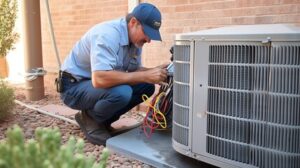An HVAC company is a business that offers installation, repair, and maintenance services for different types of heating, ventilation, and air conditioning systems. These companies are staffed with certified and licensed professionals who have years of experience in the field.

The structure of Best HVAC Companies In Cincinnati typically includes four levels. These include the top management team, sales, installation, and service teams.
The proper performance of a property’s HVAC system is critical to comfort levels and building health. Whether the property is a single-family home, apartment complex, hotel or a large office building, the HVAC equipment must be properly engineered and designed to efficiently provide conditioned air to the occupied spaces. Improper design, installation or alterations can result in expensive operating costs, failure to meet requirements and unhappy occupants.
Regular assessments are necessary to determine the condition of a property’s equipment and systems, and to ensure they are functioning properly. These assessments should be conducted every year, with special attention being paid to the fall and spring when seasonal demands place a heavier load on the heating and cooling system.
Assessments can include an examination of the ventilation system, measuring the flow and distribution of air throughout the occupied space, checking for proper volume flows, and evaluating contaminant levels. It is also important to measure air velocity and humidity regularly to make sure the HVAC system is performing as expected, which can help avoid complaints from occupants regarding draftiness or unsatisfactory air quality.
A comprehensive accounting system is vital for an HVAC company to keep track of the cost of labor, overhead and materials. It provides valuable information about the business’s finances and helps to create a budget that is effective. In addition, it is helpful for filing taxes and staying compliant with local laws and regulations.
An HVAC company with a strong financial foundation is better equipped to invest in growth and weather market fluctuations. Studies show that companies with good financial practices are 30% more likely to survive than those with poor ones. This is why a solid insurance portfolio is essential for any HVAC company.
HVAC companies that offer recurring revenue streams, such as service contracts or membership agreements, often receive higher valuations. Other factors that increase valuations include operational efficiency, technological prowess and a loyal client base. For example, a HVAC company that uses value stream mapping to reduce waste and streamlines operations can improve profit margins by 20%. These improvements can also help them to scale operations more effectively, which is a key factor in the growth of an HVAC company.
Customization
In a market crowded with HVAC competitors, it’s important to stand out. One way to do this is by offering customizable options. Many customers want to add a custom design or logo to their furnace or air conditioning unit, for example. Customization is also helpful when it comes to delivering customer service. For example, when a customer has an issue with their system, a technician should be available to help them immediately. This will keep the customer happy and make them more likely to return for future services.
Another area of customization is the use of a custom HVAC management software solution. These systems can help your business run more efficiently by tracking and reporting on data. This information can be used to improve processes and drive a healthier bottom line. In addition, these solutions can help you monitor your team’s performance and provide better customer service.
Choosing the right custom software partner for your HVAC company is crucial. It is essential to find a company that offers support and ongoing updates, as well as the ability to scale with your growth. By partnering with the right company, you can ensure that your business will thrive in a competitive industry.
A great HVAC business requires a lot of hard work and attention to detail. This includes making sure that every job runs smoothly and is completed to the highest standard. Using the right tools can make the process much easier and save you time and money.
One of the most important aspects of HVAC management is scheduling. By utilizing an advanced software solution, you can schedule and dispatch jobs to your technicians easily. This will help you spend less time on the road, save fuel, and fit more jobs into a day. It’s also important to keep your crew informed on scheduling changes. By using a scheduling tool, you can automatically send your team reminders when an appointment is added or rescheduled. This will prevent last-minute cancellations and keep your crew on track throughout the day.
The best HVAC companies have a website that stands out and provides all the information a potential customer needs to know. Often, websites built with Wix or other web-building programs fall short in this department. A customized website will show visitors that your company is unique and professional, while also ensuring that the site is optimized for SEO.
Installation
If you decide to hire an HVAC company for installation, it’s a good idea to review feedback on the BBB, Google Reviews and Yelp. Choosing a reputable company will ensure that your home or business is treated with respect, and that your heating, ventilation, air conditioning or refrigeration system is installed correctly and safely.
Before your HVAC installers start the job, they should meet with you to review the details of the install. They’ll give you an estimated time frame for the completion of the work and answer any questions or concerns you may have.
Then, they’ll assess the work site to make sure everything is ready for the install. This includes determining how much space is needed to accommodate the new HVAC equipment, checking ductwork, identifying electrical upgrades and doing drywall repairs, and turning off the gas and power to any existing systems. Then, they’ll remove the old unit and connect the new one. They’ll also connect the ductwork, which runs from your indoor air handler to each room in your home or business, and they’ll add insulation where needed.
Once the new HVAC equipment is in place, your technician will run it through a series of tests to verify that all of the parts are working together properly. They’ll check the thermostat to see if it’s set properly, test your air flow, and make any necessary adjustments to get the most efficiency out of your new heating and cooling system.
Finally, your HVAC professional will perform a final inspection before they leave your home or business. They’ll test the system again to make sure it’s running correctly and that you are comfortable with its performance. Then, they’ll turn off your gas and power to the existing system, clean up their work area, and hand you the keys to your new heating and cooling system.
If you’re looking to become an HVAC technician, be aware that the industry has rigorous standards. In addition to a high school diploma or GED certificate, you’ll need training from an accredited trade school or apprenticeship. Many schools offer programs that combine classroom instruction with hands-on experience to prepare students for careers in a variety of trades, including plumbing, electricians and sheet metal/ductwork technicians.
Maintenance
HVAC (heating, ventilation, air conditioning and refrigeration) is an essential part of residential structures like single-family homes; large apartment buildings and hotels; commercial offices, skyscrapers and hospitals; vehicles such as cars, buses, airplanes, trains and ships; and marine environments. Its purpose is to provide safe and comfortable conditions in any building by controlling temperature and humidity, using fresh air from outside.
Much like a car, an HVAC system will need regular maintenance to perform at its best and last longer. The best way to prevent expensive repair bills and potential system failure is to stay on top of routine maintenance tasks.
When you’re selecting an HVAC company to maintain your home or office, ask about their training and experience. Technicians should be certified and have a good understanding of the laws and codes that govern HVACR. Some companies also offer comprehensive service plans that include yearly inspections and maintenance visits. These plans can save you money and headaches if problems occur.
A professional HVAC technician will inspect the system, perform routine cleaning, and test and adjust the components to ensure proper operation. They’ll check refrigerant levels to make sure they’re within the manufacturer’s guidelines. They’ll also clean coils and heat exchangers to remove mold, mildew and other debris that can cause odors and reduce efficiency.
Another important part of preventative maintenance is to change the filters. Clean filters keep out dust, pollen, smoke and other irritants that can make people sick. They also improve indoor air quality by removing mildew, fungus and bacteria that can contribute to respiratory issues.
During the maintenance visit, the technician will also replace carbon monoxide detector batteries. Carbon monoxide is a dangerous gas that can be released into the air when an appliance, such as a furnace or boiler, malfunctions or breaks down. Changing the battery in a CO detector is a simple task that can help protect your family’s health and safety.
Having an HVAC company maintain your home or office will protect you from high repair bills and unnecessary system replacements. It’s a wise investment that will also keep your system running smoothly and efficiently for as long as possible.
